Analysis and Action Plan: Short Product Life Cycle Management Report
VerifiedAdded on 2020/05/16
|11
|2200
|100
Report
AI Summary
This report delves into the complexities of managing products with short life cycles, focusing on operations management strategies. It begins with a literature review exploring the significance of Product Lifecycle Management (PLM) and its impact on supply chain dynamics, emphasizing the need for interaction between Product Development and Product Introduction Processes. The analysis section examines single supply strategies, ARRP decisions, and the importance of matching supply chain strategies to the product's life cycle stage, supported by relevant figures. The report highlights the significance of understanding market trends, competitor analysis, and customer feedback. Finally, an action plan is proposed, outlining key activities such as market research, cost assessment, competitor analysis, and customer feedback mechanisms to effectively manage short product life cycles and ensure product success. The report also includes references to relevant literature and sources.

Operations Management
Paraphrase This Document
Need a fresh take? Get an instant paraphrase of this document with our AI Paraphraser

TABLE OF CONTENTS
Literature Review.......................................................................................................................3
Analysis......................................................................................................................................4
Action plan.................................................................................................................................8
References................................................................................................................................10
Literature Review.......................................................................................................................3
Analysis......................................................................................................................................4
Action plan.................................................................................................................................8
References................................................................................................................................10
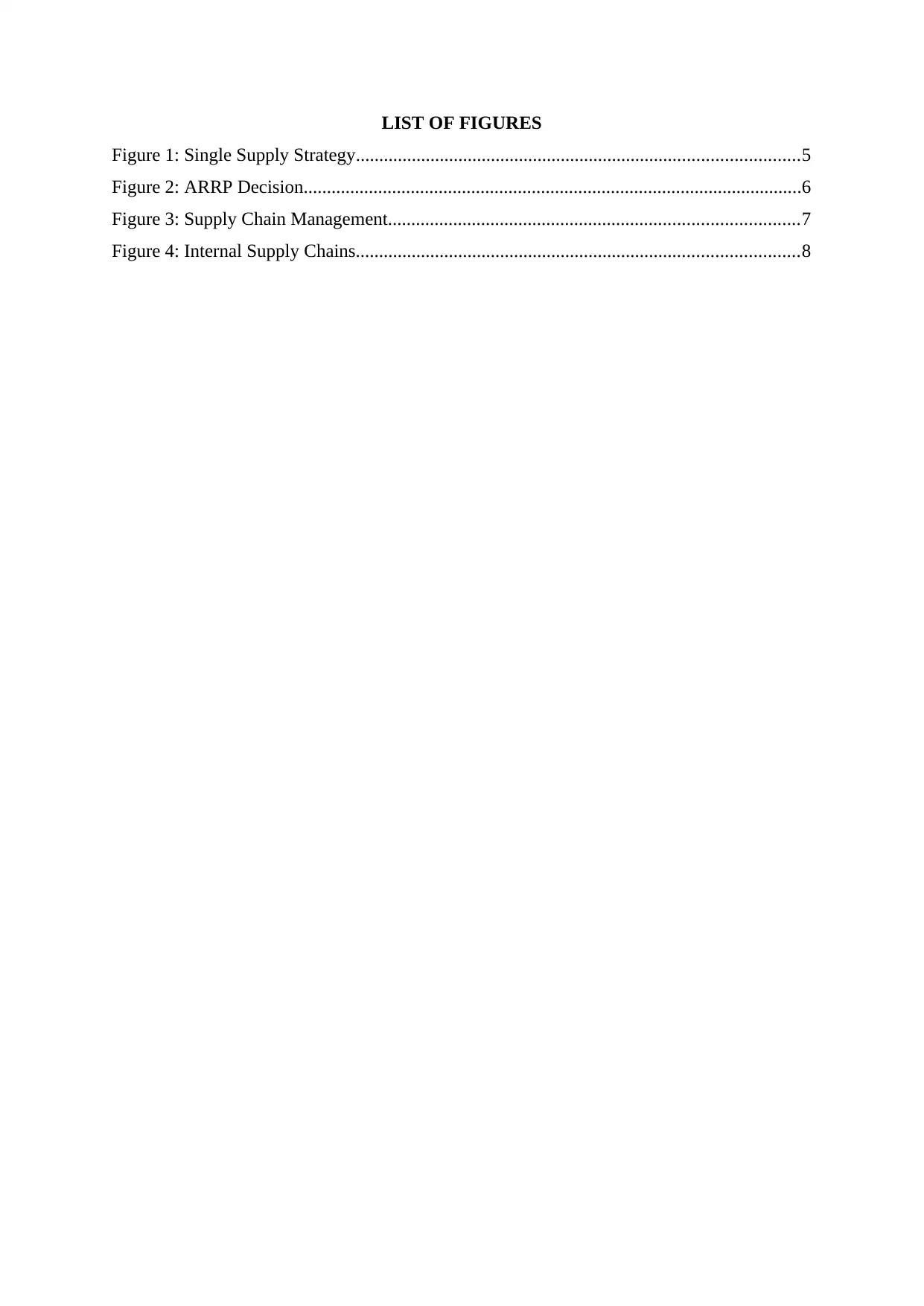
LIST OF FIGURES
Figure 1: Single Supply Strategy...............................................................................................5
Figure 2: ARRP Decision...........................................................................................................6
Figure 3: Supply Chain Management........................................................................................7
Figure 4: Internal Supply Chains...............................................................................................8
Figure 1: Single Supply Strategy...............................................................................................5
Figure 2: ARRP Decision...........................................................................................................6
Figure 3: Supply Chain Management........................................................................................7
Figure 4: Internal Supply Chains...............................................................................................8
You're viewing a preview
Unlock full access by subscribing today!
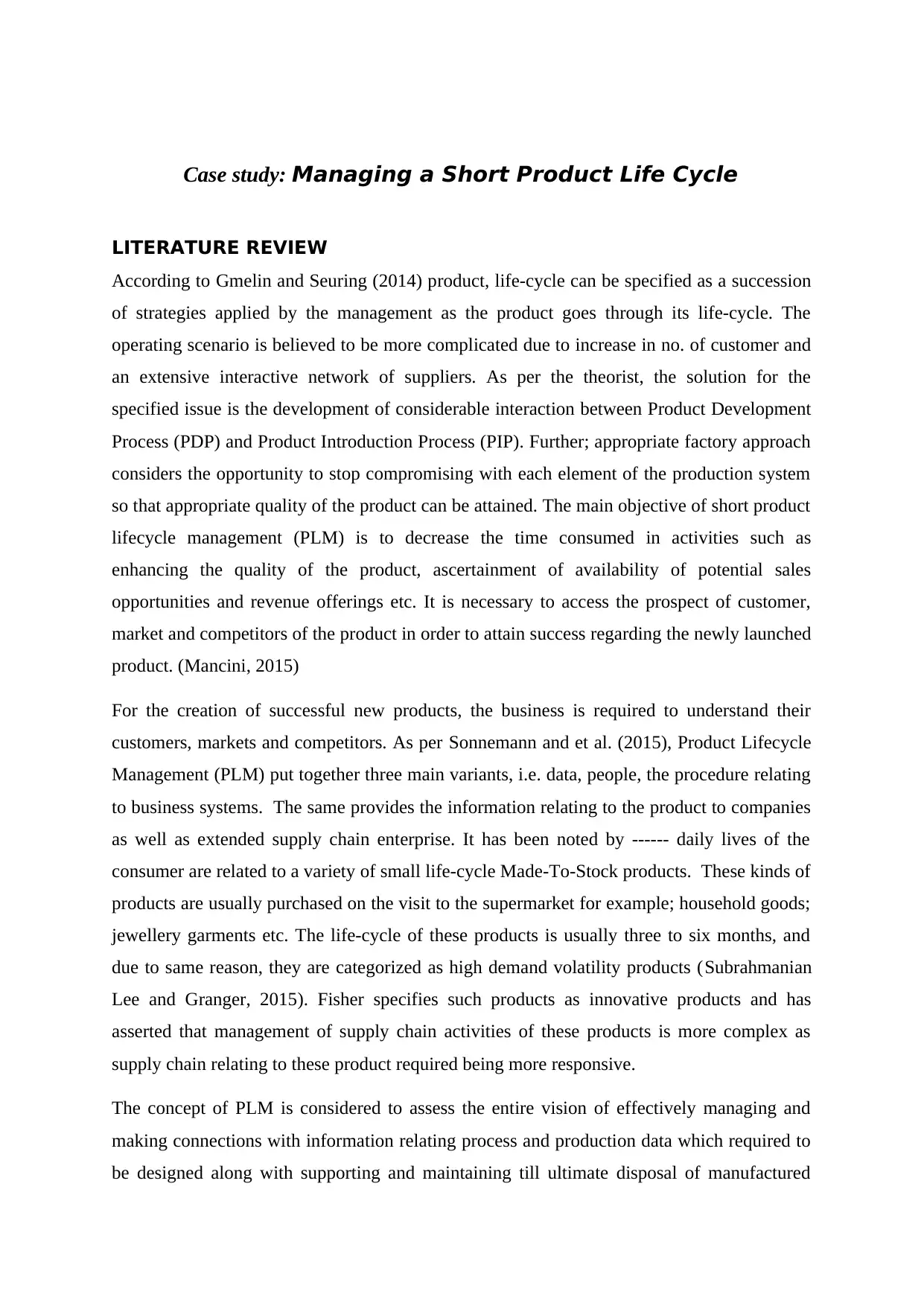
Case study: Managing a Short Product Life Cycle
LITERATURE REVIEW
According to Gmelin and Seuring (2014) product, life-cycle can be specified as a succession
of strategies applied by the management as the product goes through its life-cycle. The
operating scenario is believed to be more complicated due to increase in no. of customer and
an extensive interactive network of suppliers. As per the theorist, the solution for the
specified issue is the development of considerable interaction between Product Development
Process (PDP) and Product Introduction Process (PIP). Further; appropriate factory approach
considers the opportunity to stop compromising with each element of the production system
so that appropriate quality of the product can be attained. The main objective of short product
lifecycle management (PLM) is to decrease the time consumed in activities such as
enhancing the quality of the product, ascertainment of availability of potential sales
opportunities and revenue offerings etc. It is necessary to access the prospect of customer,
market and competitors of the product in order to attain success regarding the newly launched
product. (Mancini, 2015)
For the creation of successful new products, the business is required to understand their
customers, markets and competitors. As per Sonnemann and et al. (2015), Product Lifecycle
Management (PLM) put together three main variants, i.e. data, people, the procedure relating
to business systems. The same provides the information relating to the product to companies
as well as extended supply chain enterprise. It has been noted by ------ daily lives of the
consumer are related to a variety of small life-cycle Made-To-Stock products. These kinds of
products are usually purchased on the visit to the supermarket for example; household goods;
jewellery garments etc. The life-cycle of these products is usually three to six months, and
due to same reason, they are categorized as high demand volatility products (Subrahmanian
Lee and Granger, 2015). Fisher specifies such products as innovative products and has
asserted that management of supply chain activities of these products is more complex as
supply chain relating to these product required being more responsive.
The concept of PLM is considered to assess the entire vision of effectively managing and
making connections with information relating process and production data which required to
be designed along with supporting and maintaining till ultimate disposal of manufactured
LITERATURE REVIEW
According to Gmelin and Seuring (2014) product, life-cycle can be specified as a succession
of strategies applied by the management as the product goes through its life-cycle. The
operating scenario is believed to be more complicated due to increase in no. of customer and
an extensive interactive network of suppliers. As per the theorist, the solution for the
specified issue is the development of considerable interaction between Product Development
Process (PDP) and Product Introduction Process (PIP). Further; appropriate factory approach
considers the opportunity to stop compromising with each element of the production system
so that appropriate quality of the product can be attained. The main objective of short product
lifecycle management (PLM) is to decrease the time consumed in activities such as
enhancing the quality of the product, ascertainment of availability of potential sales
opportunities and revenue offerings etc. It is necessary to access the prospect of customer,
market and competitors of the product in order to attain success regarding the newly launched
product. (Mancini, 2015)
For the creation of successful new products, the business is required to understand their
customers, markets and competitors. As per Sonnemann and et al. (2015), Product Lifecycle
Management (PLM) put together three main variants, i.e. data, people, the procedure relating
to business systems. The same provides the information relating to the product to companies
as well as extended supply chain enterprise. It has been noted by ------ daily lives of the
consumer are related to a variety of small life-cycle Made-To-Stock products. These kinds of
products are usually purchased on the visit to the supermarket for example; household goods;
jewellery garments etc. The life-cycle of these products is usually three to six months, and
due to same reason, they are categorized as high demand volatility products (Subrahmanian
Lee and Granger, 2015). Fisher specifies such products as innovative products and has
asserted that management of supply chain activities of these products is more complex as
supply chain relating to these product required being more responsive.
The concept of PLM is considered to assess the entire vision of effectively managing and
making connections with information relating process and production data which required to
be designed along with supporting and maintaining till ultimate disposal of manufactured
Paraphrase This Document
Need a fresh take? Get an instant paraphrase of this document with our AI Paraphraser
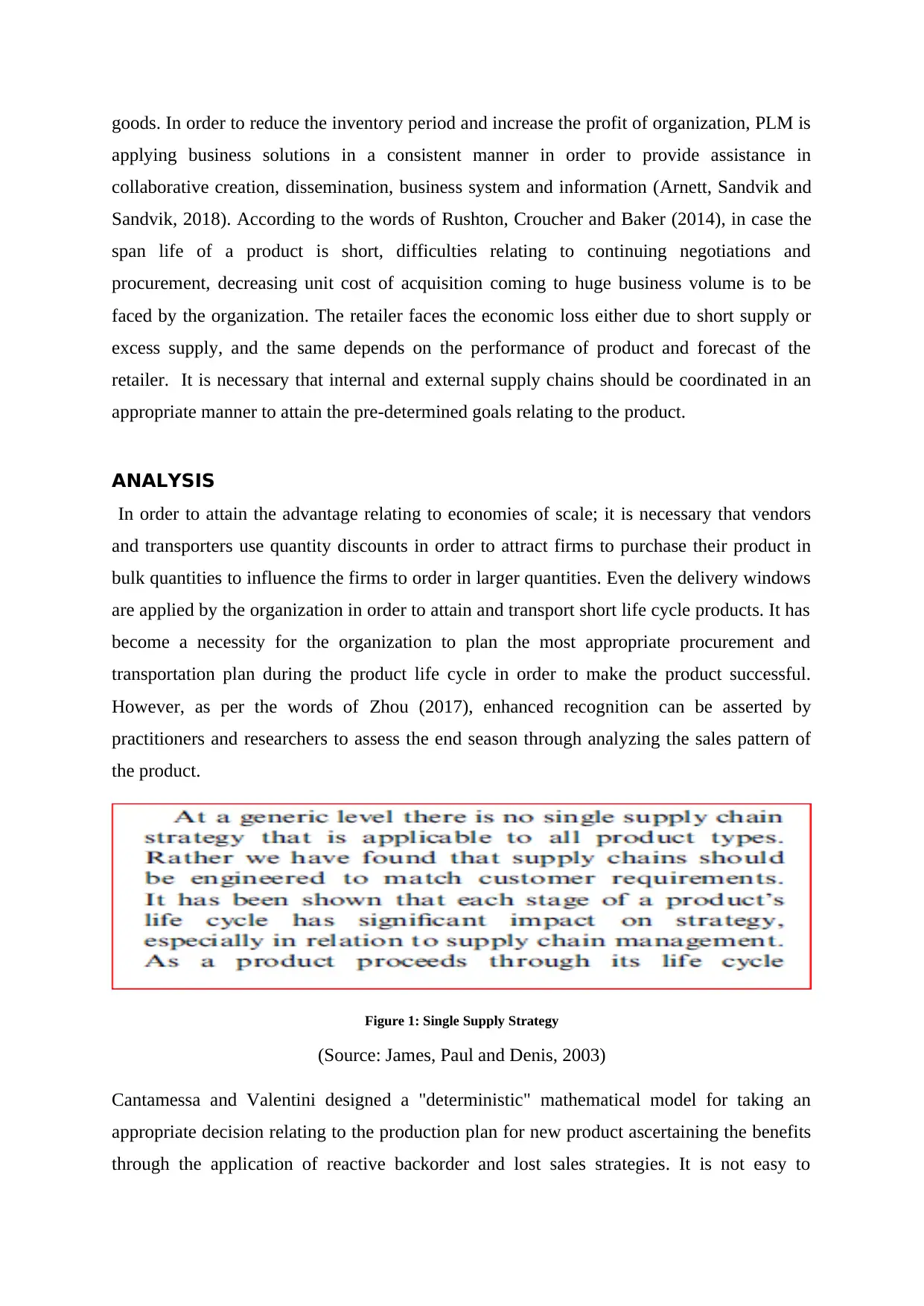
goods. In order to reduce the inventory period and increase the profit of organization, PLM is
applying business solutions in a consistent manner in order to provide assistance in
collaborative creation, dissemination, business system and information (Arnett, Sandvik and
Sandvik, 2018). According to the words of Rushton, Croucher and Baker (2014), in case the
span life of a product is short, difficulties relating to continuing negotiations and
procurement, decreasing unit cost of acquisition coming to huge business volume is to be
faced by the organization. The retailer faces the economic loss either due to short supply or
excess supply, and the same depends on the performance of product and forecast of the
retailer. It is necessary that internal and external supply chains should be coordinated in an
appropriate manner to attain the pre-determined goals relating to the product.
ANALYSIS
In order to attain the advantage relating to economies of scale; it is necessary that vendors
and transporters use quantity discounts in order to attract firms to purchase their product in
bulk quantities to influence the firms to order in larger quantities. Even the delivery windows
are applied by the organization in order to attain and transport short life cycle products. It has
become a necessity for the organization to plan the most appropriate procurement and
transportation plan during the product life cycle in order to make the product successful.
However, as per the words of Zhou (2017), enhanced recognition can be asserted by
practitioners and researchers to assess the end season through analyzing the sales pattern of
the product.
Figure 1: Single Supply Strategy
(Source: James, Paul and Denis, 2003)
Cantamessa and Valentini designed a "deterministic" mathematical model for taking an
appropriate decision relating to the production plan for new product ascertaining the benefits
through the application of reactive backorder and lost sales strategies. It is not easy to
applying business solutions in a consistent manner in order to provide assistance in
collaborative creation, dissemination, business system and information (Arnett, Sandvik and
Sandvik, 2018). According to the words of Rushton, Croucher and Baker (2014), in case the
span life of a product is short, difficulties relating to continuing negotiations and
procurement, decreasing unit cost of acquisition coming to huge business volume is to be
faced by the organization. The retailer faces the economic loss either due to short supply or
excess supply, and the same depends on the performance of product and forecast of the
retailer. It is necessary that internal and external supply chains should be coordinated in an
appropriate manner to attain the pre-determined goals relating to the product.
ANALYSIS
In order to attain the advantage relating to economies of scale; it is necessary that vendors
and transporters use quantity discounts in order to attract firms to purchase their product in
bulk quantities to influence the firms to order in larger quantities. Even the delivery windows
are applied by the organization in order to attain and transport short life cycle products. It has
become a necessity for the organization to plan the most appropriate procurement and
transportation plan during the product life cycle in order to make the product successful.
However, as per the words of Zhou (2017), enhanced recognition can be asserted by
practitioners and researchers to assess the end season through analyzing the sales pattern of
the product.
Figure 1: Single Supply Strategy
(Source: James, Paul and Denis, 2003)
Cantamessa and Valentini designed a "deterministic" mathematical model for taking an
appropriate decision relating to the production plan for new product ascertaining the benefits
through the application of reactive backorder and lost sales strategies. It is not easy to
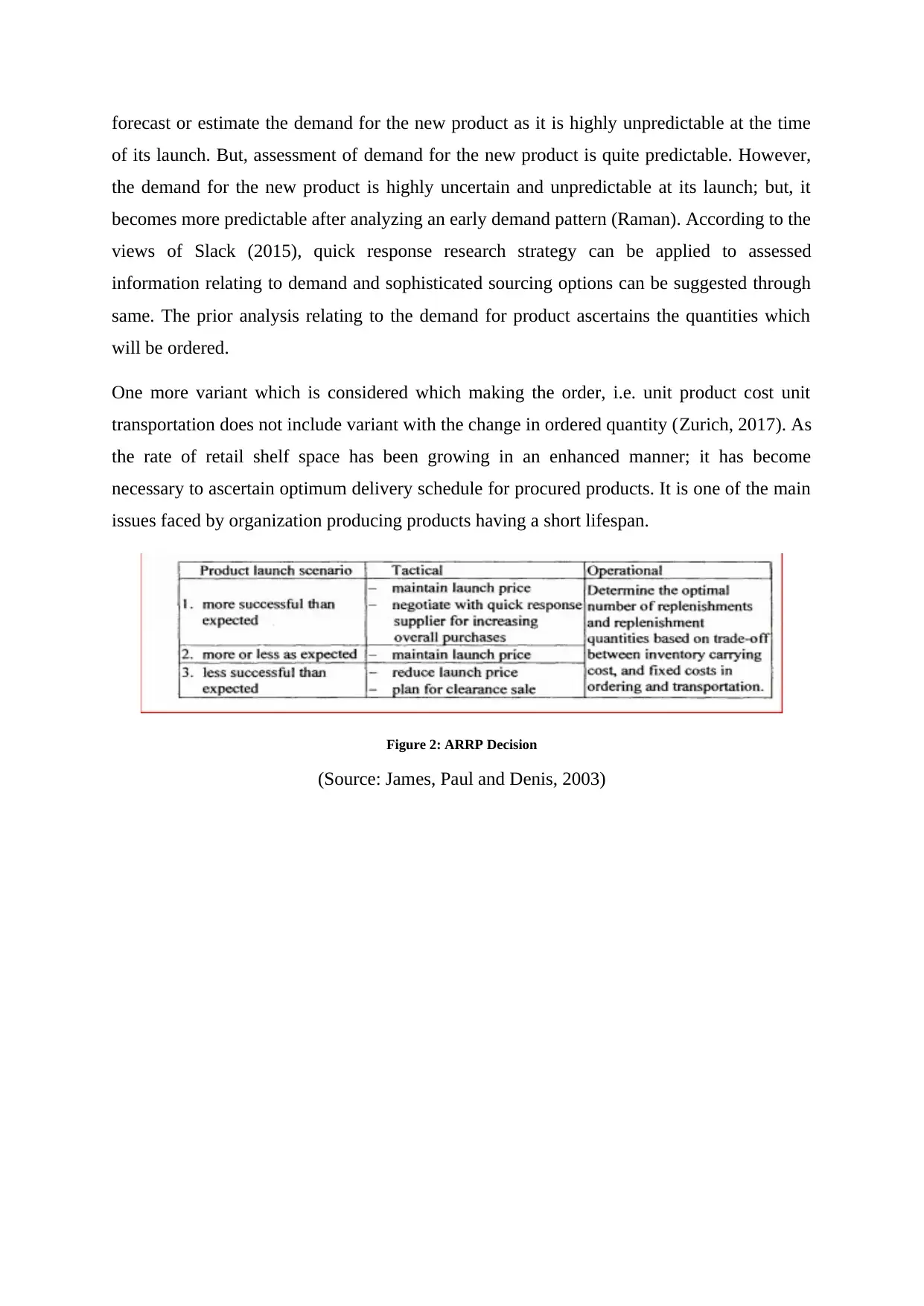
forecast or estimate the demand for the new product as it is highly unpredictable at the time
of its launch. But, assessment of demand for the new product is quite predictable. However,
the demand for the new product is highly uncertain and unpredictable at its launch; but, it
becomes more predictable after analyzing an early demand pattern (Raman). According to the
views of Slack (2015), quick response research strategy can be applied to assessed
information relating to demand and sophisticated sourcing options can be suggested through
same. The prior analysis relating to the demand for product ascertains the quantities which
will be ordered.
One more variant which is considered which making the order, i.e. unit product cost unit
transportation does not include variant with the change in ordered quantity (Zurich, 2017). As
the rate of retail shelf space has been growing in an enhanced manner; it has become
necessary to ascertain optimum delivery schedule for procured products. It is one of the main
issues faced by organization producing products having a short lifespan.
Figure 2: ARRP Decision
(Source: James, Paul and Denis, 2003)
of its launch. But, assessment of demand for the new product is quite predictable. However,
the demand for the new product is highly uncertain and unpredictable at its launch; but, it
becomes more predictable after analyzing an early demand pattern (Raman). According to the
views of Slack (2015), quick response research strategy can be applied to assessed
information relating to demand and sophisticated sourcing options can be suggested through
same. The prior analysis relating to the demand for product ascertains the quantities which
will be ordered.
One more variant which is considered which making the order, i.e. unit product cost unit
transportation does not include variant with the change in ordered quantity (Zurich, 2017). As
the rate of retail shelf space has been growing in an enhanced manner; it has become
necessary to ascertain optimum delivery schedule for procured products. It is one of the main
issues faced by organization producing products having a short lifespan.
Figure 2: ARRP Decision
(Source: James, Paul and Denis, 2003)
You're viewing a preview
Unlock full access by subscribing today!
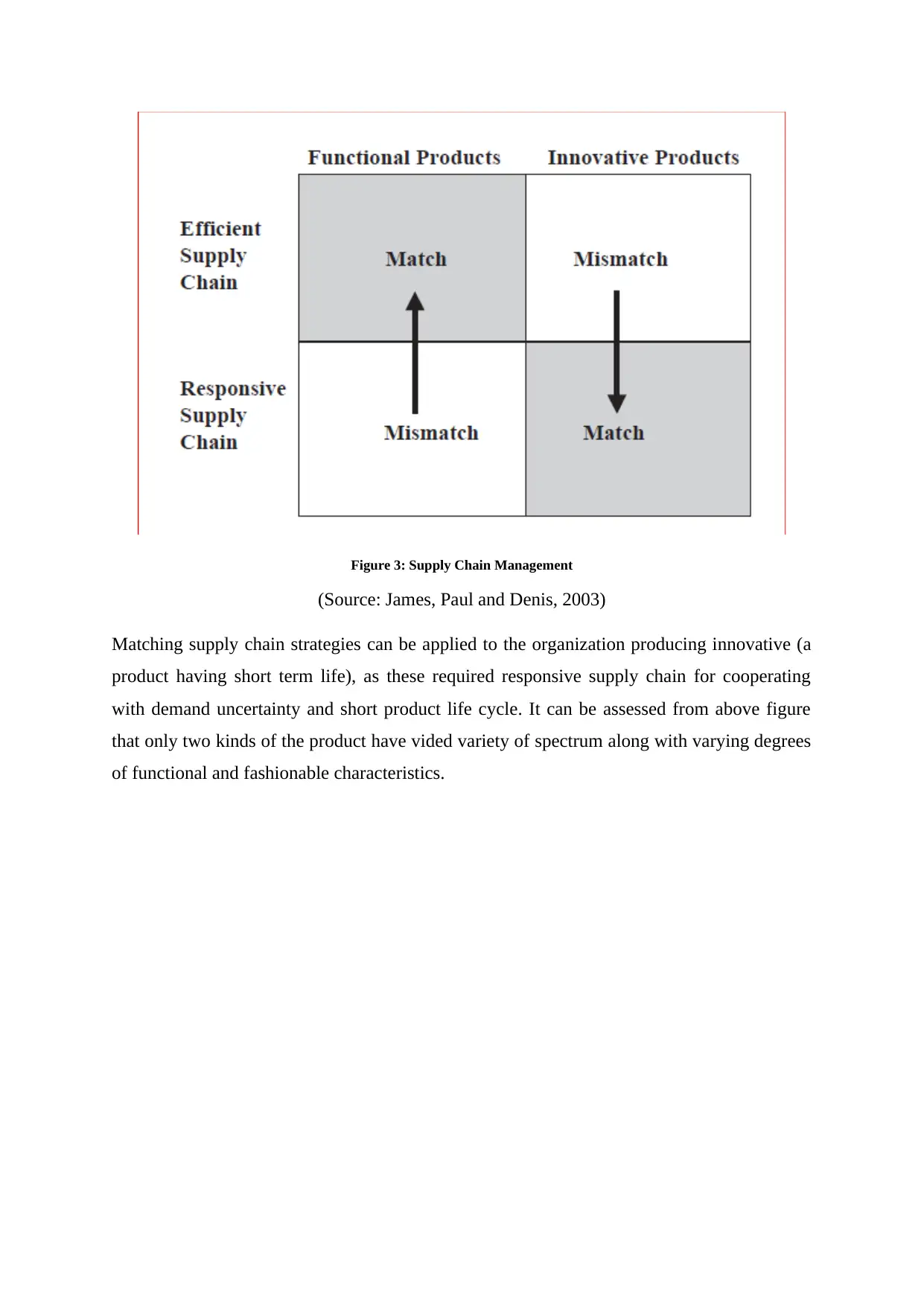
Figure 3: Supply Chain Management
(Source: James, Paul and Denis, 2003)
Matching supply chain strategies can be applied to the organization producing innovative (a
product having short term life), as these required responsive supply chain for cooperating
with demand uncertainty and short product life cycle. It can be assessed from above figure
that only two kinds of the product have vided variety of spectrum along with varying degrees
of functional and fashionable characteristics.
(Source: James, Paul and Denis, 2003)
Matching supply chain strategies can be applied to the organization producing innovative (a
product having short term life), as these required responsive supply chain for cooperating
with demand uncertainty and short product life cycle. It can be assessed from above figure
that only two kinds of the product have vided variety of spectrum along with varying degrees
of functional and fashionable characteristics.
Paraphrase This Document
Need a fresh take? Get an instant paraphrase of this document with our AI Paraphraser
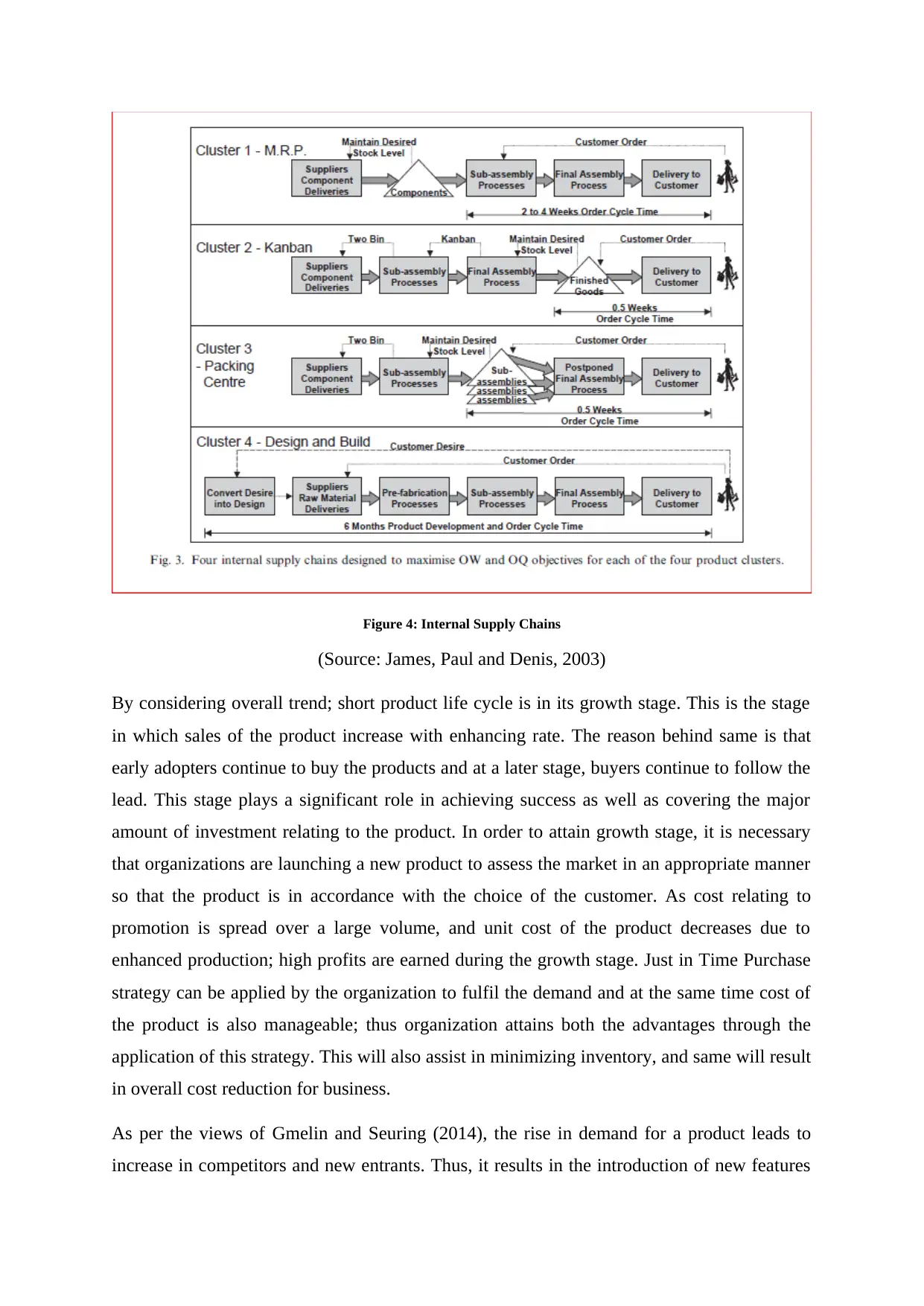
Figure 4: Internal Supply Chains
(Source: James, Paul and Denis, 2003)
By considering overall trend; short product life cycle is in its growth stage. This is the stage
in which sales of the product increase with enhancing rate. The reason behind same is that
early adopters continue to buy the products and at a later stage, buyers continue to follow the
lead. This stage plays a significant role in achieving success as well as covering the major
amount of investment relating to the product. In order to attain growth stage, it is necessary
that organizations are launching a new product to assess the market in an appropriate manner
so that the product is in accordance with the choice of the customer. As cost relating to
promotion is spread over a large volume, and unit cost of the product decreases due to
enhanced production; high profits are earned during the growth stage. Just in Time Purchase
strategy can be applied by the organization to fulfil the demand and at the same time cost of
the product is also manageable; thus organization attains both the advantages through the
application of this strategy. This will also assist in minimizing inventory, and same will result
in overall cost reduction for business.
As per the views of Gmelin and Seuring (2014), the rise in demand for a product leads to
increase in competitors and new entrants. Thus, it results in the introduction of new features
(Source: James, Paul and Denis, 2003)
By considering overall trend; short product life cycle is in its growth stage. This is the stage
in which sales of the product increase with enhancing rate. The reason behind same is that
early adopters continue to buy the products and at a later stage, buyers continue to follow the
lead. This stage plays a significant role in achieving success as well as covering the major
amount of investment relating to the product. In order to attain growth stage, it is necessary
that organizations are launching a new product to assess the market in an appropriate manner
so that the product is in accordance with the choice of the customer. As cost relating to
promotion is spread over a large volume, and unit cost of the product decreases due to
enhanced production; high profits are earned during the growth stage. Just in Time Purchase
strategy can be applied by the organization to fulfil the demand and at the same time cost of
the product is also manageable; thus organization attains both the advantages through the
application of this strategy. This will also assist in minimizing inventory, and same will result
in overall cost reduction for business.
As per the views of Gmelin and Seuring (2014), the rise in demand for a product leads to
increase in competitors and new entrants. Thus, it results in the introduction of new features
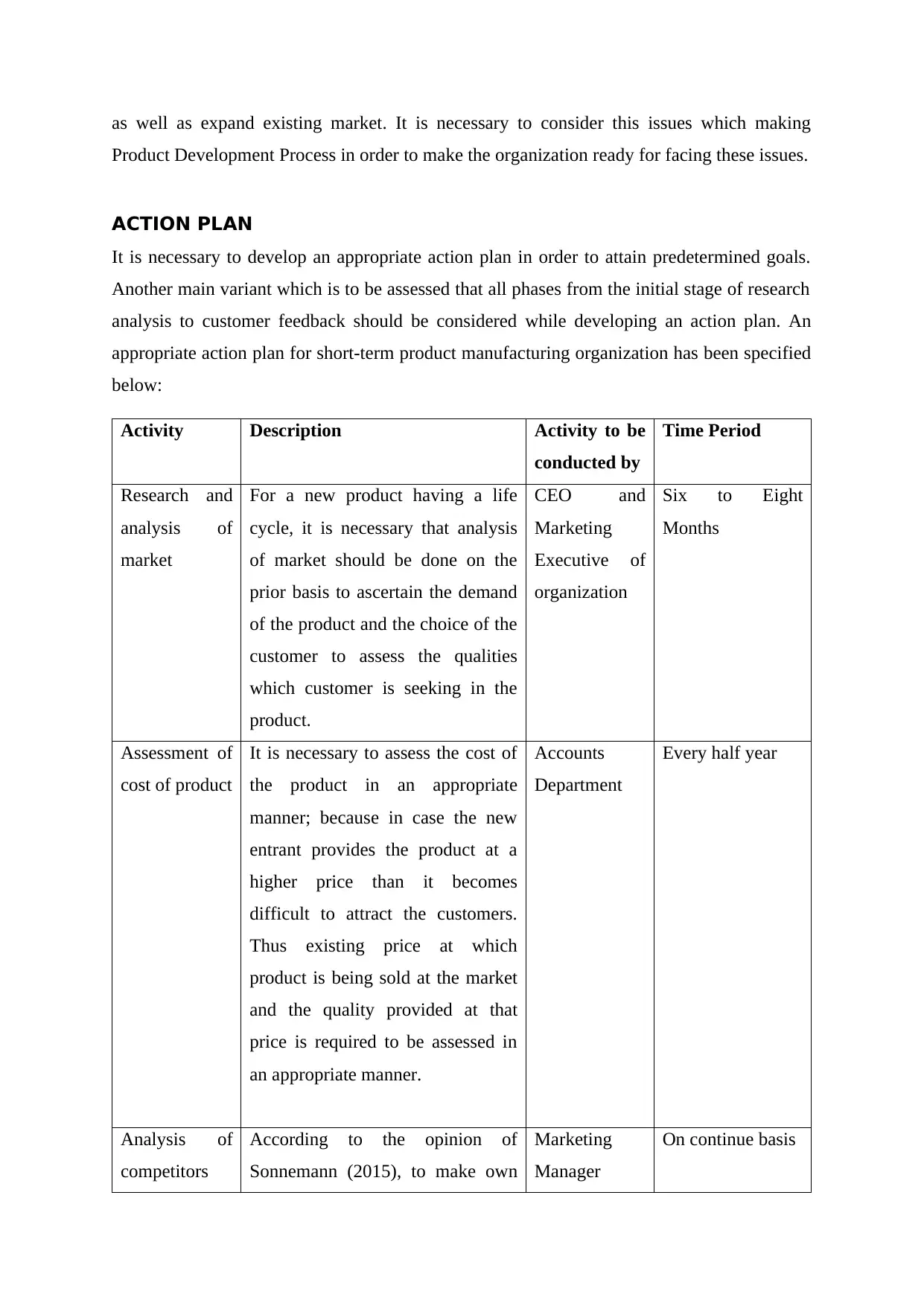
as well as expand existing market. It is necessary to consider this issues which making
Product Development Process in order to make the organization ready for facing these issues.
ACTION PLAN
It is necessary to develop an appropriate action plan in order to attain predetermined goals.
Another main variant which is to be assessed that all phases from the initial stage of research
analysis to customer feedback should be considered while developing an action plan. An
appropriate action plan for short-term product manufacturing organization has been specified
below:
Activity Description Activity to be
conducted by
Time Period
Research and
analysis of
market
For a new product having a life
cycle, it is necessary that analysis
of market should be done on the
prior basis to ascertain the demand
of the product and the choice of the
customer to assess the qualities
which customer is seeking in the
product.
CEO and
Marketing
Executive of
organization
Six to Eight
Months
Assessment of
cost of product
It is necessary to assess the cost of
the product in an appropriate
manner; because in case the new
entrant provides the product at a
higher price than it becomes
difficult to attract the customers.
Thus existing price at which
product is being sold at the market
and the quality provided at that
price is required to be assessed in
an appropriate manner.
Accounts
Department
Every half year
Analysis of
competitors
According to the opinion of
Sonnemann (2015), to make own
Marketing
Manager
On continue basis
Product Development Process in order to make the organization ready for facing these issues.
ACTION PLAN
It is necessary to develop an appropriate action plan in order to attain predetermined goals.
Another main variant which is to be assessed that all phases from the initial stage of research
analysis to customer feedback should be considered while developing an action plan. An
appropriate action plan for short-term product manufacturing organization has been specified
below:
Activity Description Activity to be
conducted by
Time Period
Research and
analysis of
market
For a new product having a life
cycle, it is necessary that analysis
of market should be done on the
prior basis to ascertain the demand
of the product and the choice of the
customer to assess the qualities
which customer is seeking in the
product.
CEO and
Marketing
Executive of
organization
Six to Eight
Months
Assessment of
cost of product
It is necessary to assess the cost of
the product in an appropriate
manner; because in case the new
entrant provides the product at a
higher price than it becomes
difficult to attract the customers.
Thus existing price at which
product is being sold at the market
and the quality provided at that
price is required to be assessed in
an appropriate manner.
Accounts
Department
Every half year
Analysis of
competitors
According to the opinion of
Sonnemann (2015), to make own
Marketing
Manager
On continue basis
You're viewing a preview
Unlock full access by subscribing today!
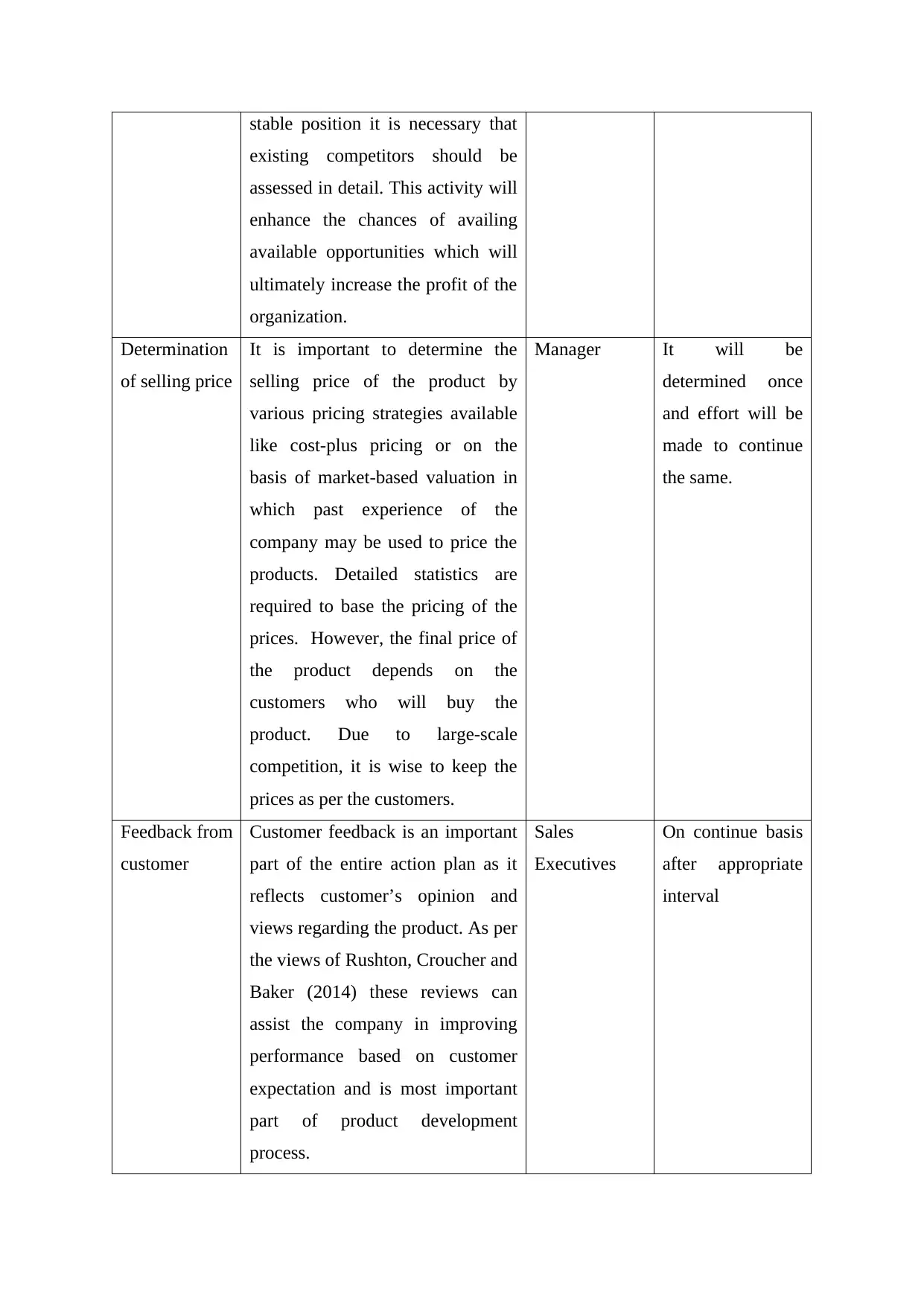
stable position it is necessary that
existing competitors should be
assessed in detail. This activity will
enhance the chances of availing
available opportunities which will
ultimately increase the profit of the
organization.
Determination
of selling price
It is important to determine the
selling price of the product by
various pricing strategies available
like cost-plus pricing or on the
basis of market-based valuation in
which past experience of the
company may be used to price the
products. Detailed statistics are
required to base the pricing of the
prices. However, the final price of
the product depends on the
customers who will buy the
product. Due to large-scale
competition, it is wise to keep the
prices as per the customers.
Manager It will be
determined once
and effort will be
made to continue
the same.
Feedback from
customer
Customer feedback is an important
part of the entire action plan as it
reflects customer’s opinion and
views regarding the product. As per
the views of Rushton, Croucher and
Baker (2014) these reviews can
assist the company in improving
performance based on customer
expectation and is most important
part of product development
process.
Sales
Executives
On continue basis
after appropriate
interval
existing competitors should be
assessed in detail. This activity will
enhance the chances of availing
available opportunities which will
ultimately increase the profit of the
organization.
Determination
of selling price
It is important to determine the
selling price of the product by
various pricing strategies available
like cost-plus pricing or on the
basis of market-based valuation in
which past experience of the
company may be used to price the
products. Detailed statistics are
required to base the pricing of the
prices. However, the final price of
the product depends on the
customers who will buy the
product. Due to large-scale
competition, it is wise to keep the
prices as per the customers.
Manager It will be
determined once
and effort will be
made to continue
the same.
Feedback from
customer
Customer feedback is an important
part of the entire action plan as it
reflects customer’s opinion and
views regarding the product. As per
the views of Rushton, Croucher and
Baker (2014) these reviews can
assist the company in improving
performance based on customer
expectation and is most important
part of product development
process.
Sales
Executives
On continue basis
after appropriate
interval
Paraphrase This Document
Need a fresh take? Get an instant paraphrase of this document with our AI Paraphraser
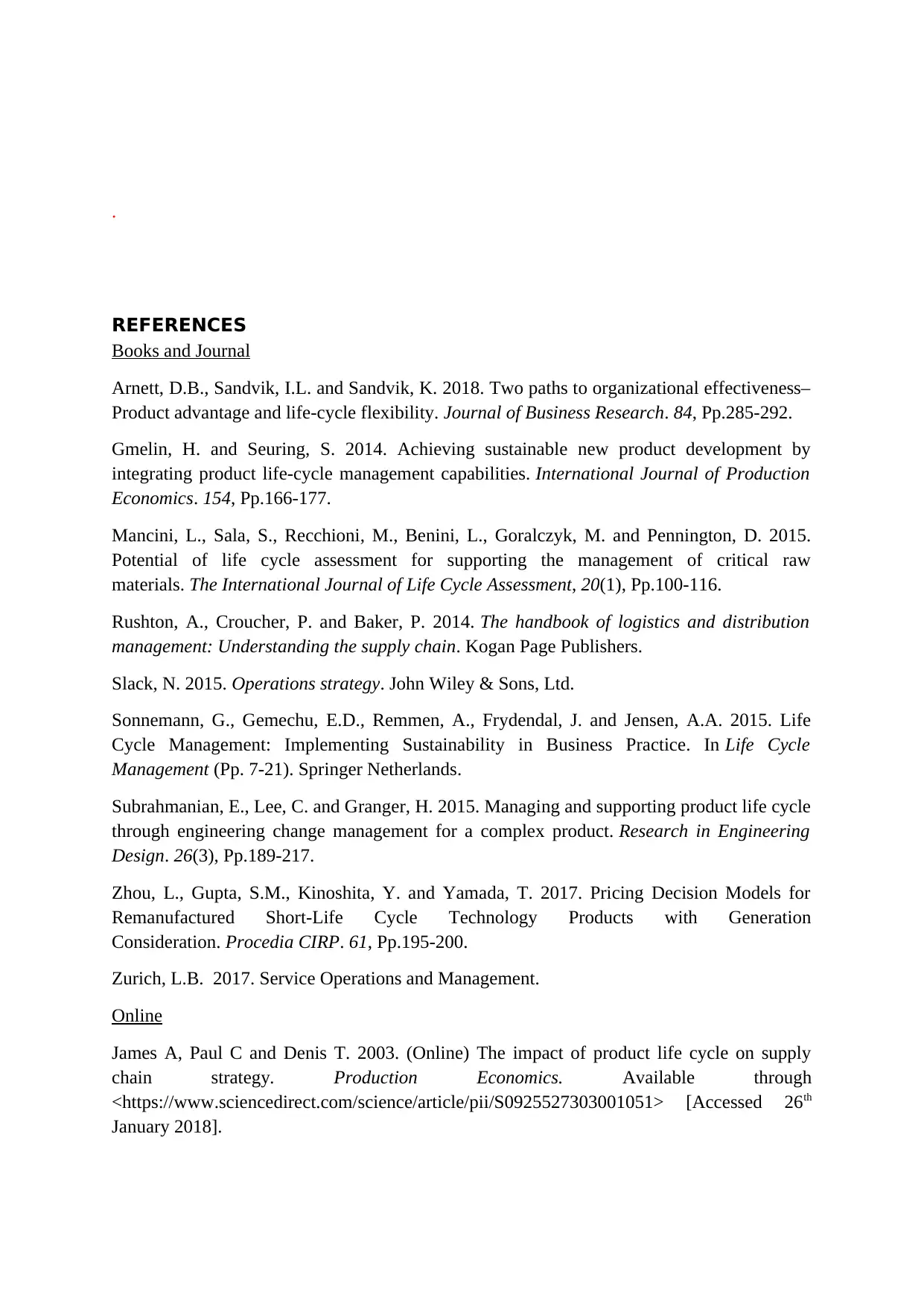
.
REFERENCES
Books and Journal
Arnett, D.B., Sandvik, I.L. and Sandvik, K. 2018. Two paths to organizational effectiveness–
Product advantage and life-cycle flexibility. Journal of Business Research. 84, Pp.285-292.
Gmelin, H. and Seuring, S. 2014. Achieving sustainable new product development by
integrating product life-cycle management capabilities. International Journal of Production
Economics. 154, Pp.166-177.
Mancini, L., Sala, S., Recchioni, M., Benini, L., Goralczyk, M. and Pennington, D. 2015.
Potential of life cycle assessment for supporting the management of critical raw
materials. The International Journal of Life Cycle Assessment, 20(1), Pp.100-116.
Rushton, A., Croucher, P. and Baker, P. 2014. The handbook of logistics and distribution
management: Understanding the supply chain. Kogan Page Publishers.
Slack, N. 2015. Operations strategy. John Wiley & Sons, Ltd.
Sonnemann, G., Gemechu, E.D., Remmen, A., Frydendal, J. and Jensen, A.A. 2015. Life
Cycle Management: Implementing Sustainability in Business Practice. In Life Cycle
Management (Pp. 7-21). Springer Netherlands.
Subrahmanian, E., Lee, C. and Granger, H. 2015. Managing and supporting product life cycle
through engineering change management for a complex product. Research in Engineering
Design. 26(3), Pp.189-217.
Zhou, L., Gupta, S.M., Kinoshita, Y. and Yamada, T. 2017. Pricing Decision Models for
Remanufactured Short-Life Cycle Technology Products with Generation
Consideration. Procedia CIRP. 61, Pp.195-200.
Zurich, L.B. 2017. Service Operations and Management.
Online
James A, Paul C and Denis T. 2003. (Online) The impact of product life cycle on supply
chain strategy. Production Economics. Available through
<https://www.sciencedirect.com/science/article/pii/S0925527303001051> [Accessed 26th
January 2018].
REFERENCES
Books and Journal
Arnett, D.B., Sandvik, I.L. and Sandvik, K. 2018. Two paths to organizational effectiveness–
Product advantage and life-cycle flexibility. Journal of Business Research. 84, Pp.285-292.
Gmelin, H. and Seuring, S. 2014. Achieving sustainable new product development by
integrating product life-cycle management capabilities. International Journal of Production
Economics. 154, Pp.166-177.
Mancini, L., Sala, S., Recchioni, M., Benini, L., Goralczyk, M. and Pennington, D. 2015.
Potential of life cycle assessment for supporting the management of critical raw
materials. The International Journal of Life Cycle Assessment, 20(1), Pp.100-116.
Rushton, A., Croucher, P. and Baker, P. 2014. The handbook of logistics and distribution
management: Understanding the supply chain. Kogan Page Publishers.
Slack, N. 2015. Operations strategy. John Wiley & Sons, Ltd.
Sonnemann, G., Gemechu, E.D., Remmen, A., Frydendal, J. and Jensen, A.A. 2015. Life
Cycle Management: Implementing Sustainability in Business Practice. In Life Cycle
Management (Pp. 7-21). Springer Netherlands.
Subrahmanian, E., Lee, C. and Granger, H. 2015. Managing and supporting product life cycle
through engineering change management for a complex product. Research in Engineering
Design. 26(3), Pp.189-217.
Zhou, L., Gupta, S.M., Kinoshita, Y. and Yamada, T. 2017. Pricing Decision Models for
Remanufactured Short-Life Cycle Technology Products with Generation
Consideration. Procedia CIRP. 61, Pp.195-200.
Zurich, L.B. 2017. Service Operations and Management.
Online
James A, Paul C and Denis T. 2003. (Online) The impact of product life cycle on supply
chain strategy. Production Economics. Available through
<https://www.sciencedirect.com/science/article/pii/S0925527303001051> [Accessed 26th
January 2018].
1 out of 11
Related Documents
Your All-in-One AI-Powered Toolkit for Academic Success.
+13062052269
info@desklib.com
Available 24*7 on WhatsApp / Email
![[object Object]](/_next/static/media/star-bottom.7253800d.svg)
Unlock your academic potential
© 2024 | Zucol Services PVT LTD | All rights reserved.





